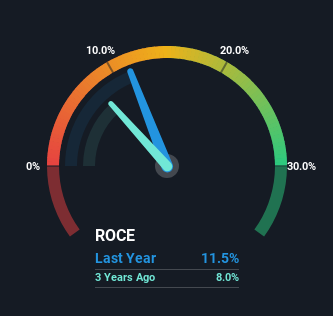- Brazil
- /
- Consumer Services
- /
- BOVESPA:CSED3
Here's What's Concerning About Cruzeiro do Sul Educacional's (BVMF:CSED3) Returns On Capital
Finding a business that has the potential to grow substantially is not easy, but it is possible if we look at a few key financial metrics. Ideally, a business will show two trends; firstly a growing return on capital employed (ROCE) and secondly, an increasing amount of capital employed. This shows us that it's a compounding machine, able to continually reinvest its earnings back into the business and generate higher returns. However, after briefly looking over the numbers, we don't think Cruzeiro do Sul Educacional (BVMF:CSED3) has the makings of a multi-bagger going forward, but let's have a look at why that may be.
Return On Capital Employed (ROCE): What Is It?
For those that aren't sure what ROCE is, it measures the amount of pre-tax profits a company can generate from the capital employed in its business. To calculate this metric for Cruzeiro do Sul Educacional, this is the formula:
Return on Capital Employed = Earnings Before Interest and Tax (EBIT) ÷ (Total Assets - Current Liabilities)
0.11 = R$438m ÷ (R$4.8b - R$1.0b) (Based on the trailing twelve months to June 2024).
Therefore, Cruzeiro do Sul Educacional has an ROCE of 11%. In absolute terms, that's a pretty normal return, and it's somewhat close to the Consumer Services industry average of 9.8%.
View our latest analysis for Cruzeiro do Sul Educacional

Above you can see how the current ROCE for Cruzeiro do Sul Educacional compares to its prior returns on capital, but there's only so much you can tell from the past. If you're interested, you can view the analysts predictions in our free analyst report for Cruzeiro do Sul Educacional .
What Can We Tell From Cruzeiro do Sul Educacional's ROCE Trend?
On the surface, the trend of ROCE at Cruzeiro do Sul Educacional doesn't inspire confidence. Over the last five years, returns on capital have decreased to 11% from 19% five years ago. Although, given both revenue and the amount of assets employed in the business have increased, it could suggest the company is investing in growth, and the extra capital has led to a short-term reduction in ROCE. And if the increased capital generates additional returns, the business, and thus shareholders, will benefit in the long run.
On a related note, Cruzeiro do Sul Educacional has decreased its current liabilities to 21% of total assets. That could partly explain why the ROCE has dropped. Effectively this means their suppliers or short-term creditors are funding less of the business, which reduces some elements of risk. Some would claim this reduces the business' efficiency at generating ROCE since it is now funding more of the operations with its own money.
In Conclusion...
While returns have fallen for Cruzeiro do Sul Educacional in recent times, we're encouraged to see that sales are growing and that the business is reinvesting in its operations. And there could be an opportunity here if other metrics look good too, because the stock has declined 42% in the last three years. So we think it'd be worthwhile to look further into this stock given the trends look encouraging.
One more thing to note, we've identified 2 warning signs with Cruzeiro do Sul Educacional and understanding them should be part of your investment process.
While Cruzeiro do Sul Educacional isn't earning the highest return, check out this free list of companies that are earning high returns on equity with solid balance sheets.
New: AI Stock Screener & Alerts
Our new AI Stock Screener scans the market every day to uncover opportunities.
• Dividend Powerhouses (3%+ Yield)
• Undervalued Small Caps with Insider Buying
• High growth Tech and AI Companies
Or build your own from over 50 metrics.
Have feedback on this article? Concerned about the content? Get in touch with us directly. Alternatively, email editorial-team (at) simplywallst.com.
This article by Simply Wall St is general in nature. We provide commentary based on historical data and analyst forecasts only using an unbiased methodology and our articles are not intended to be financial advice. It does not constitute a recommendation to buy or sell any stock, and does not take account of your objectives, or your financial situation. We aim to bring you long-term focused analysis driven by fundamental data. Note that our analysis may not factor in the latest price-sensitive company announcements or qualitative material. Simply Wall St has no position in any stocks mentioned.
About BOVESPA:CSED3
Undervalued with high growth potential.
Market Insights
Community Narratives


Recently Updated Narratives

TAV Havalimanlari Holding will fly high with 25.68% revenue growth


Fiducian: Compliance Clouds or Value Opportunity?


Q3 Outlook modestly optimistic
Popular Narratives


MicroVision will explode future revenue by 380.37% with a vision towards success


The company that turned a verb into a global necessity and basically runs the modern internet, digital ads, smartphones, maps, and AI.



